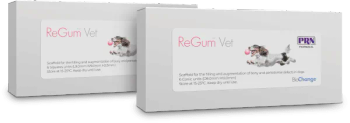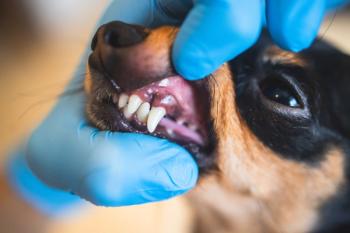
Quick tips to get to the root of periodontal disease
If pets in your veterinary clinic are plagued by plaque, take a moment to review Dr. Barden Greenfields advice on pockets, probing and why you should always keep a backup scaler tip.
Probing to measure periodontal pocket depth. (All images courtesy of Dr. Greenfield.)According to the American Veterinary Medical Association, 80% of dogs over the age of 3 have some form of periodontal disease. And this huge number may be on the rise thanks to an increase in the popularity of smaller dogs, which typically experience periodontal disease at a younger age.
Education tip: A visual is worth a thousand words in the exam room. Use thiol strips to demonstrate the presence of plaque to clients in a quick, compelling way.
CVC educator Barden Greenfield, DVM, DAVDC, explains that at the root of periodontal disease is plaque (which contains 100 trillion bacterial cells in every gram) under the gum line. It causes “pockets” to form around teeth as bone and gum tissue, which normally fit tightly around each tooth, are destroyed.
The goal of periodontal therapy is to prevent bone loss, because bone loss is a big deal. In humans, alveolar bone loss increases risk of death more than smoking.
A Williams probe.Go pocket probing
Shrink those pockets: Normal probing depths vary between small and large dogs and between dogs and cats. In small dogs, the maximum normal pocket depth is 2 mm, while it can be up to 3 mm in large dogs. You can reduce pocket sizes with doxycycline hyclate (Doxirobe Gel-Zoetis), Dr. Greenfield says.
To determine the amount of bone loss, Dr. Greenfield says you'll need to use a probe to measure periodontal pocket depths. Radiographs can't detect cortical bone loss until it reaches 40%. Thus, it's important to trust your probes because it's possible to have significant bone loss before it shows up on a radiograph. Dr. Greenfield specifically recommends Williams probes.
A thiol strip being used to demonstrate the presence of plaque.Don't let pets be plagued by plaque
A quick reminder of the four stages of periodontal disease
Stage 1 (gingivitis): The only reversible stage, its signs include bleeding, swelling and glistening gingiva-but not bone loss. Identifying and treating gingivitis early on can successfully prevent more serious problems from developing.
Stage 2: This stage involves bone loss of less than 25% and periodontal pocket depths of 3 to 5 mm. According to Dr. Greenfield, “While this may not be severe for a large-breed pet such as a golden retriever or Rottweiler, it can be extremely severe in a pet under 5 kg.”
Stage 3: Bone loss of more than 25% and less than 50% is characteristic of this stage, which “has a variable treatment plan based on the tooth size and amount of attachment loss,” Dr. Greenfield says.
Stage 4: With more 50% bone loss, teeth in this stage are hanging on for dear life. Extractions are the only option.
Gram-positive bacteria in the mouth aren't a source of worry, Dr. Greenfield says. It's when they convert to the gram-negative anaerobes that they wreak havoc. Plaque bacteria are 100 times more resistant to antiseptics, and antibiotics won't resolve the problem either. But mechanical removal will.
When removing the plaque under the gums, don't forget to also remove the subgingival epithelium. And remember to change your scaler tips every month or so too. Doing so will save you time in the long run. Dr. Greenfield advises to always keep a backup scaler tip. (I learned the importance of this the hard way when the scaler tip broke halfway through a dental. The client never came back to finish.)
Send clients home with oral rinses, diets and dental chews approved by the Veterinary Oral Health Council.
Newsletter
From exam room tips to practice management insights, get trusted veterinary news delivered straight to your inbox—subscribe to dvm360.






